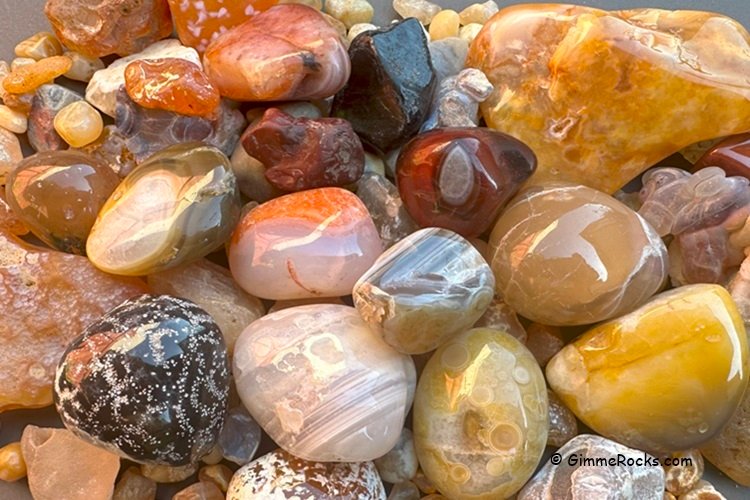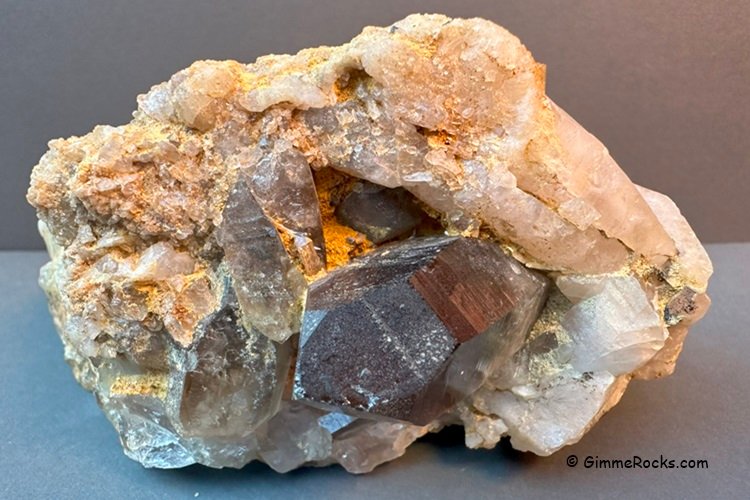The Earth boasts a remarkable diversity of minerals with about 5,000 varieties known to humankind. Mineral identification can be a challenging task for rock enthusiasts, as certain minerals from distinct groups may share resemblances, and even minerals of the same type can exhibit variations in color and other properties.
While advanced and often costly equipment for mineral identification is available through modern technology, basic home tests remain effective for the majority of common minerals.
Home key identification relays on the examination of physical properties. These properties act as guides, leading observers through a series of choices that help narrow down possibilities and ultimately identify the mineral.
How are Minerals Identified?
Most minerals can be easily identified by their appearance or by using basic tests with a few simple tools. There are a few steps you can perform in the order is listed below:
The first, observe the color, transparency, luster, and shape. If it is a crystal, what is its habit? Write down all your finding.
If you still are not sure in the mineral identity, perform hardness, streak, and specific gravity tests with basic tools.
Fracture, cleavage, and tenacity describing how a mineral breaks or cracks are also help to distinguish a mineral.
Other less common properties such as fluorescence, magnetism, radioactivity, and a chemical reaction on acid can aid in identification of some specimens.
Color
Color is obvious and important property for identification but it can be misleading. Unlike minerals such as gold or pyrite, which typically occur in only one color, many other minerals can exhibit variable colors or may even be colorless.
The variations in color within the same mineral species are often caused by factors such as impurities, slight changes in chemical composition, or differences in crystal structures. Therefore, while color can provide valuable clues, especially in conjunction with other identifying characteristics, it should not be relied upon exclusively when attempting to identify minerals.

Transparency
Transparency refers to the way in which light passes through a mineral.
Transparent luster – light is transmitting completely. If some object behind this specimen is clearly to be seen, the mineral is transparent.
When light passes through, but the object behind cannot be clearly seen, then the mineral is translucent.
If light doesn’t pass through a mineral, even when cut thin, it is opaque.
Luster
Luster is a specimen appearance, appraisal property showing how a mineral surface reflects and retracts light. Luster depends on crystal structure, mineral composition, and surface conditions. If it is scratched or weathered may have a duller luster than freshly broken or tumbled naturally. The types of luster are well-described by terms and can be determined by observation.
There are two broad categories: Metallic and nonmetallic.
Metallic and Submetallic Luster
Minerals with metallic luster are opaque, transmitting no light even on thin edges. Additional tests like streak can aid in distinguishing whether a specimen has a metallic or nonmetallic luster. Metals end to be soft, more powdered material may be obtained from the streak. Minerals with metallic luster tend to exhibit a thick dense, dark streak.
Example: Gold, silver, copper, steel, galena, pyrite.
Submetallic may be translucent or transparent. Example: Hematite and magnetite.
Nonmetallic Luster
Nonmetallic luster is divided into groups based on reflective effect.
- Vitreous: Resembling the reflective quality of broken glass. Refractive index 1.5 -2. Example: Calcite, quartz, topaz, beryl, tourmaline, fluorite.
- Dull or earthy: Do not shine, little or no reflection; composed of an aggregate of tiny grains. Example: Kaolinite.
- Greasy: Appears to be covered with a thin layer of oil. Example: Graphite, halite, orpiment, and green serpentine.
- Pearly: Iridescent, opalescent, or pearly. Parallel to planes of perfect cleavage. Layer silicates. Example: Mica and talc.
- Resinous: Sheen resembling that of resin. Refractive index is above 2. Example: Amber, sphalerite.
- Silky: Light is reflected off of an aggregate of fine parallel fibers. Example: Malachite, serpentine, asbestos, borate ulexite, satin spar.
- Waxy: Resembling wax. Example: Jade and chalcedony.
- Adamantine: Brilliant and sparkling as diamond with refracting indices 1.9-2.6, highly dispersive and translucent. Covalent bonding or presence of heavy metal atoms. Example: Cerussite, zircon, cubic zirconia.
Hardness
The Mohs scale is a relative hardness scale, from 1 (softest, talc) to 10 (hardest, diamond). This is widely used in mineralogy to identify minerals based on their ability to scratch or be scratched by other substances.
For instance, quartz (hardness 7) can scratch orthoclase (hardness 6) but not topaz (hardness 8).
Streak
A mineral’s streak (the color of its powdered form) is a reliable identification tool because it tends to remain constant, even when the color of the mineral varies.
Some minerals have surprising streak colors, such as hematite, which is often black or silver but has a reddish-brown streak.
Specific Gravity
Specific gravity (SG) is an important property in mineral identification. It’s a dimensionless quantity, as it represents the ratio of the density of a mineral to the density of water (usually at 4°C where water has a density of 1 g/cm³). Knowing a mineral’s specific gravity can help distinguish similar-looking minerals, as it is a consistent physical property across different specimens.
To measure specific gravity accurately, instruments like a hydrostatic balance are often used. Another common method is by using a pycnometer or heavy liquids. The hydrostatic method involves weighing the mineral in air and then weighing it while suspended in water. The difference in weight allows the specific gravity to be calculated.
For rockhounding and mineral collecting, a simple home test using an electronic balance can be performed to help identify minerals. While not as precise as scientific methods, this test can effectively distinguish between minerals when their specific gravities differ significantly.
Crystal Habits
Understanding these crystal systems helps in identifying minerals, as their external shape often mirrors the symmetry and dimensions of their internal atomic structure. For example, minerals in the isometric system tend to form cubic shapes, while those in the hexagonal system often form hexagonal prisms.
A mineral’s crystal form is the outward geometric shape that reflects its internal atomic structure. Crystals form in regular, repeating patterns based on the arrangement of atoms in the lattice structure.

Under favorable conditions, these geometric forms are easily recognizable, though often, environmental factors like space, temperature, and pressure may prevent the formation of large, well-defined crystals. In these cases, the mineral may appear as smaller crystals or massive, meaning it lacks a visible external crystal shape but still retains its internal crystalline structure.
Minerals like limonite and opal are classified as Amorphous Minerals because they do not have a regular, repeating atomic structure. Instead, their atoms are arranged randomly, which prevents them from forming crystals.
Crystal Systems
Crystals are classified into six major geometric systems based on their symmetry and the lengths and angles of their axes:
- Isometric (Cubic): All three axes are of equal length and intersect at 90° angles. Examples: halite, pyrite.
- Tetragonal: Two axes are of equal length, and one is longer or shorter, all meeting at 90° angles. Example: zircon.
- Hexagonal: Has four axes: three of equal length in one plane and one perpendicular to them, which can be longer or shorter. A rhombohedral subdivision applies mainly to carbonates, like calcite.
- Orthorhombic: Three axes of unequal length, all intersecting at 90° angles. Example: olivine.
- Monoclinic: Two axes intersect at 90°, but the third axis is inclined. Example: gypsum.
- Triclinic: All three axes are of unequal length and intersect at angles other than 90°. Example: kyanite.
Cleavade and Fracture
Cleavage describes how a mineral breaks along planes of weakness in its atomic structure. This breakage occurs in specific geometric forms, such as cubic (like halite), octahedral (like fluorite), rhombohedral (like calcite), and prismatic (like amphiboles).
Minerals with good cleavage tend to break along smooth, flat surfaces that are often shiny. For instance, mica has a very prominent single-direction cleavage that allows it to split into thin sheets.
Minerals that don’t have cleavage tend to fracture, meaning they break irregularly rather than along defined planes. Quartz is a classic example of a mineral with conchoidal fracture, which means it breaks with smooth, curved surfaces, similar to the way glass breaks.
Tenacity
Tenacity measures a mineral’s resistance to breaking, bending, cutting, or deforming, and it comes in several forms:
- Brittle: Easily crumbles or breaks, like pyrite.
- Ductile: Can be stretched into thin wires, like copper.
- Elastic: Can bend but will return to its original shape, as seen in mica minerals like muscovite.
- Malleable: Can be flattened into thin sheets without breaking, a property seen in metals like gold.
- Sectile: Can be sliced or cut with a knife, like gypsum or galena.
Additional Mineral Identification Tests
All next three techniques add extra layers of identification for minerals in the field or lab, complementing tests like hardness, streak, and cleavage.
Fluorescence
Some minerals such as fluorite, calcite, gypsum, halite, sodalite, araginite, and adamite will fluoresce in neon colors when viewed under an ultraviolet light.
However, fluorescence is considered one of the less reliable indicators for mineral identification due to its lack of consistency. While some minerals from the same location may exhibit fluorescence, others may not, even if they appear similar in appearance. Therefore, while fluorescence can be a fascinating characteristic, it should be used cautiously and in conjunction with other identifying factors when assessing minerals.
Acid Test
This is a key method for identifying carbonate minerals, especially calcite. When cold, dilute hydrochloric acid (HCl) is dropped onto a carbonate mineral, it reacts by fizzing and releasing carbon dioxide gas. This reaction can also happen with other carbonate minerals like dolomite, though dolomite may only react with warm or concentrated acid.
Sulfide minerals, like pyrite, galena, and sphalerite, can produce a rotten-egg smell when exposed to acid, due to the release of hydrogen sulfide gas. This distinct odor is a good indicator when identifying sulfide minerals.
Magnetism
Minerals that are magnetic can be tested using a simple magnet. Magnetite is the most well-known example of a magnetic mineral and can be easily attracted to a magnet. Pyrrhotite is another magnetic mineral, though it’s less common.
Magnetic properties are not only useful for identifying minerals but also for recognizing materials like meteorites, which often contain high amounts of iron-nickel alloys and can be strongly magnetic. In rare cases, as you mentioned, magnetic minerals are found in certain geological formations like kimberlite pipes, which are related to deep volcanic activity.
